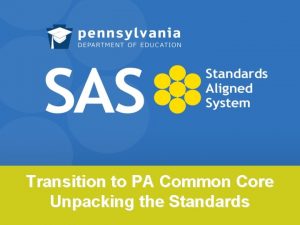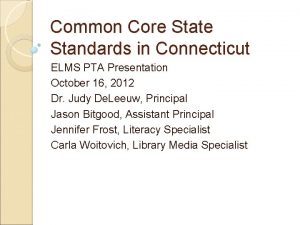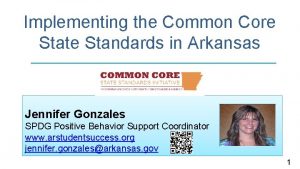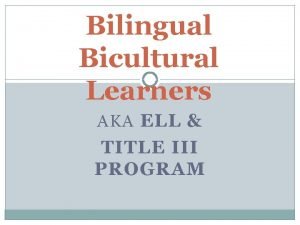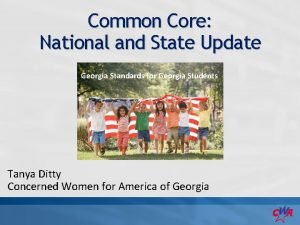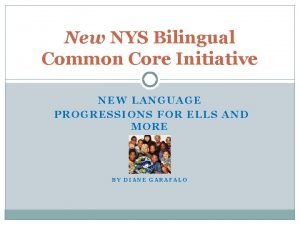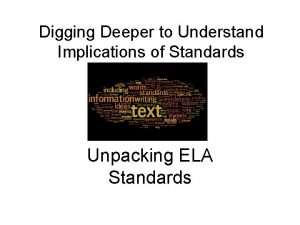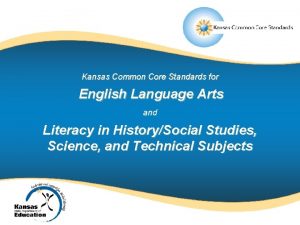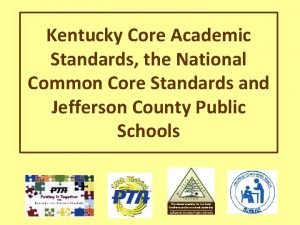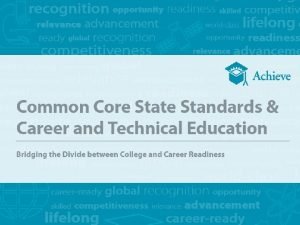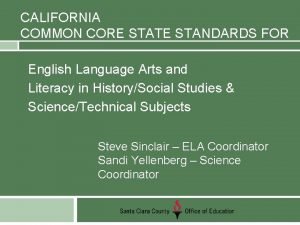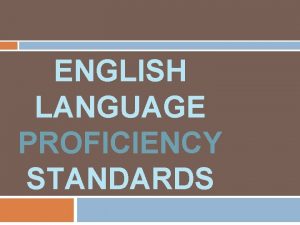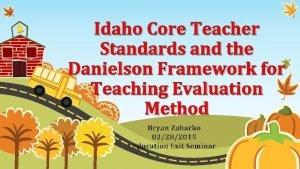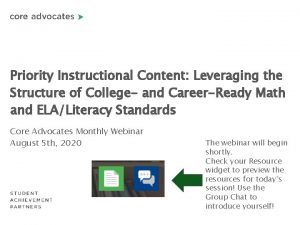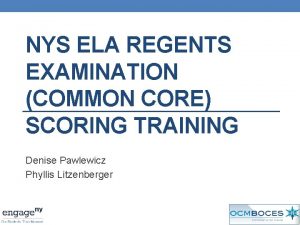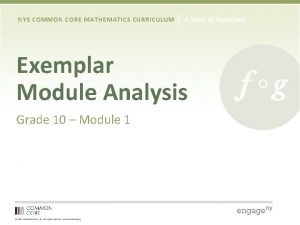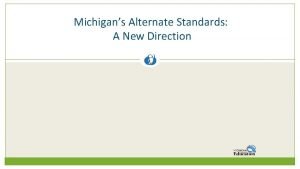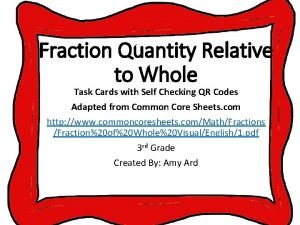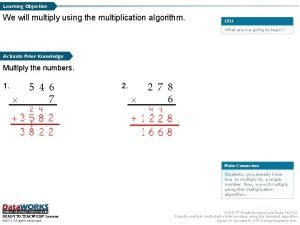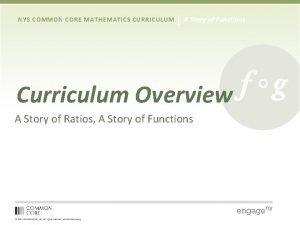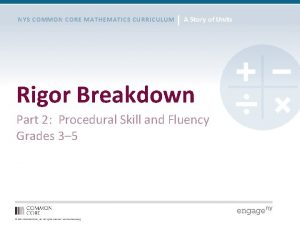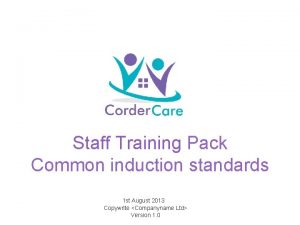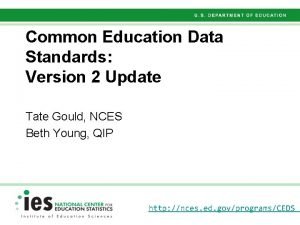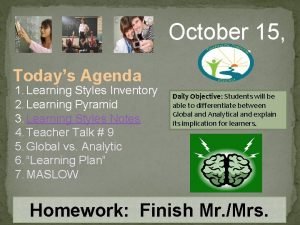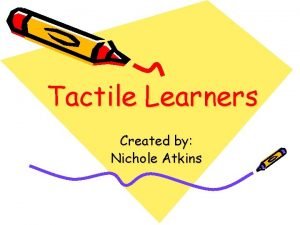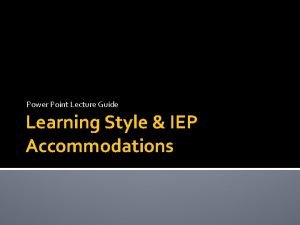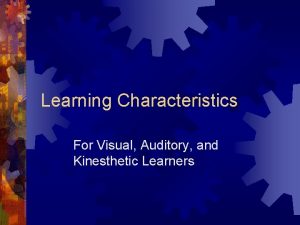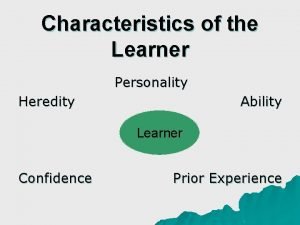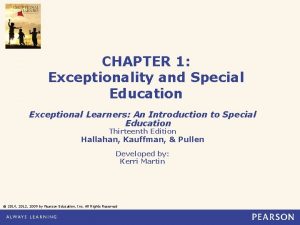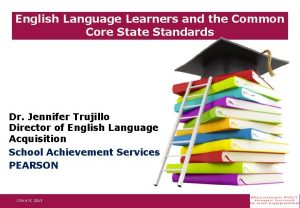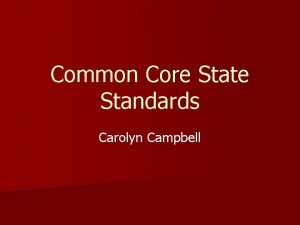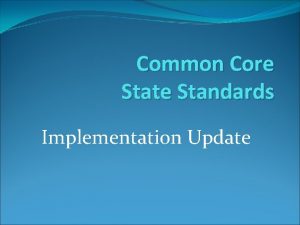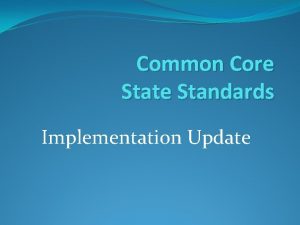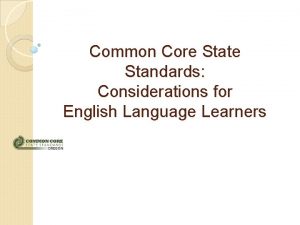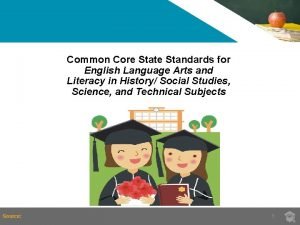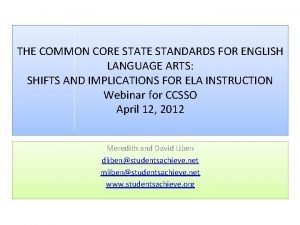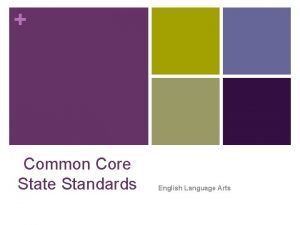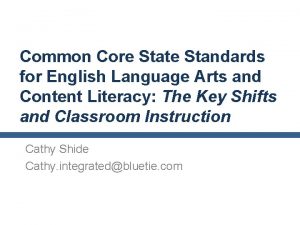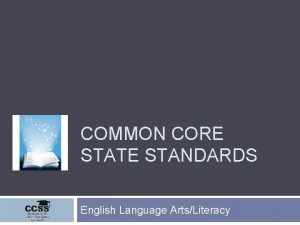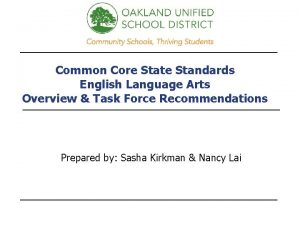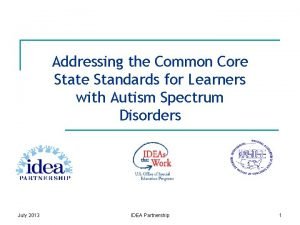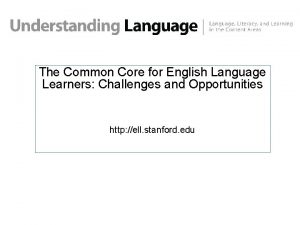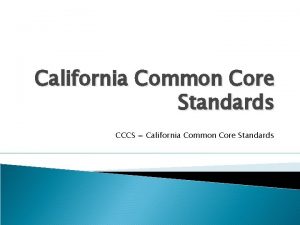Common Core State Standards and English Language Learners

































































- Slides: 65

Common Core State Standards and English Language Learners Michelle Sandoval

Workshop outline 1. 2. 3. 4. 5. 6. Before Common Core State Standards (CCSS) Adoption of CCSS Common Core Criticism Preparing Parents Teacher Preparation

Workshop outline 7. English Learners (ELs) 8. Implications for ELs 9. Benefits of being an EL 10. Language Demands 11. Roles of Stakeholders 12. Strategies to access and comprehend complex text

Purpose This project aims to provide techniques by which ELs can work toward standards attainment. The main focus is how ELs can benefit and engage in content learning with proper support.

Before Common Core Beginning in 2001, President George W. Bush proposed the No Child Left Behind Act (NCLB) to monitor school progress. States design: Standards Assessments Proficiency levels

Common Core State Standards (CCSS)

Common Core State Standards (CCSS) The CCSS initiative would create common educational standards, prepare students for college, stress quality education for all students, and increase rigor in schools.

Importance Consistency across states Clear expectations (i. e. , skills and knowledge) Preparedness for collaboration and competition with peers in the U. S. and outside.

Development State education chiefs and governors in 48 states collaborated with teachers, researchers, and leading experts to design and develop the Common Core State Standards.

English Language Arts (ELA) & Mathematics ELA and mathematics were chosen because they include skills necessary for all other content areas. The knowledge and skills students need in order to meet the end goal of college and career readiness.

Old vs. New Old: • States designed: • Standards • Assessments • Proficiency levels New: • Common Standards • Fewer topics at each grade level • Require deeper understanding than old standards Math and Language Arts: • Reading and understanding informational texts • Deeper understanding of mathematical concepts and the use of skills to solve practical problems

A side-by-side comparison of math expectations Previous Math Question CCSS Math Question Each shirt costs $4. How much do 3 shirts cost? Each shirt has 6 buttons. How many buttons are needed to make 7 shirts? This question can be answered by a “count-all” strategy, in which you don’t need to know your multiplication tables by memory to get the right answer. This question requires automatic recall of multiplication tables to get at the right answer. Source: Foundation for Excellence in Education

A side-by-side comparison of English expectations Student task before Common Core Student task with Common Core Students retell the main events (e. g. , beginning, middle, end) of Frog and Toad Together, and identify the characters and the setting of the story. Students compare and contrast the adventures and experiences of Frog and Toad in Frog and Toad Together, and participate in collaborative conversations about their comparisons. Source: Foundation for Excellence in Education

A Common Core of Readiness Today: A clear criteria has been established where CCSS reflect college and career readiness. Before: State standards were developed by using a variety of criteria which resulted in long list of standards that might or might not have anything to do with college and career readiness.

Acquisition In most states, the state school board members formally adopted the standards. In others, the decision was made or ratified by the state superintendent of education, state legislature, or governor.

CCSS Adoptions

Adoption It is unconstitutional for the federal government to mandate CCSS adoption; therefore, individual states voluntarily adopt either the ELA, Mathematics, or both sets of standards (CCSSI, 2014).

Financial incentives Race to the Top Fund (RTT) NCLB waiver

RTT criteria Adopt standards and assessments that prepare students to succeed in college and the workplace and to compete in the global economy. Build data systems that measure student growth and success, and inform teachers and principals about how they can improve instruction. Recruit, develop, reward, and retain effective teachers and principals. Turning around our lowest-achieving schools.

NCLB Criteria States’ educational agencies must adopt college and career ready standards. State educational agencies that eliminate CCSS are unable to maintain the waiver.

Common Core Criticism On a piece of paper please write the pros and cons of CCSS.

Pros and Cons Pros • Internationally benchmarked • Teachers teaching the same stand • Increase in critical thinking and problem solving skills • Tool to monitor students progress • Common standards • High level thinking (i. e. , development of own answer and defending them) • Rigor in the classroom Cons • New ways of teaching and learning • Standards are broad and not very specific • Academic rigor starts in pre-k • Online assessments • High stakes testing • States with higher stand. must accept lower stand. • Lack of specialized testing • No stand. for history or social studies • Loss of teachers and admin.

The Journey The Common Core standards offer a clear framework of what students should be able to do (the skills), not what they should know (the content). It is not about the finished product so much as it is about the experience that led to the product (Gardner & Powell, 2013).

Result It is unclear how differences in teaching style will affect the outcome of CCSS. There is no way to predict a positive or negative outcome without implementation.

Parental view As schools begin to implement Common Core parents will start hearing about the new standards. The way teachers communicate their views about standards will solidify parental view.


Collaborating Haycock & Policy Innovators in Education (2012) indicated that if teachers are enthusiastic in standardsrelated professional development it will come across to parents and will be contagious.

Communication Plan Teacher communication will solidify parental views. Positive views will allow parents to view CCSS positively. Inform parents of possible low performances

Preparing Teachers To understand shifts in instruction and to learn how to adjust their practices teachers will need consistent support and training.

Preparing Teachers cont. Support & training: Aligning assignments to CCSS Literacy Design Cooperative Math Design Cooperative The Teaching Channel Learn Zillion (i. e. , videos, assessments, and progress reporting)

Immigrant Children

Demographic Trends Fastest growing segment of U. S. population Immigrant children account for 25 percent of the 70. 2 million children under age 18 in the U. S. 17. 4 million children under age 18 lived at home with at least one immigrant parent (Nwosu et. al, 2014)

Risk Factors Child birth place Rights and responsibilities Homes where English is not spoken Lag behind in reading and math Parents have little to no education Failure to master English in the early grades

Pedagogical Implications ELs must work with texts in a language they are still developing.

Failure to master English Undermines scholastic achievement, educational attainment, and economic mobility (Heckman, 2006). Basic literacy and numeracy often provide entry to secure jobs that pay a family wage.

Challenges Schools must address ELs language, literacy, and academic needs. ELs lack literacy in their first language and typically attain low proficiency, if any, in English. ELs are placed in classes with same aged peers. Complicates learning environment for teachers and peers. ELs become pressured and frustrated to meet (NCLB).

Benefits of being an EL

Benefits of being an EL Primary language literacy skills are transferable. Background knowledge to construct text meaning. Text concerns content with which the second language learner is familiar.

Language Demands As schools across the nation begin to implement the CCSS, the need for defining and understanding how to teach academic English is more pertinent than before.

BICS Most of the language EL students bring to school is social language, or Basic Interpersonal Communication Skills (BICS).

CALP According to Cummins (1980) students develop the ability to cope with the academic demands, Cognitive Academic Language Proficiency (CALP), through application, analysis, synthesis, and evaluation of language in school settings.

SNL & CCL Bailey and Heritage (2008) broaden the conceptualization of school language use by breaking academic English into School Navigational Language (SNL) and Curriculum Content Language (CCL).

SNL & CCL cont. SNL Refers to the language through which students communicate with peers and teachers, including teacher instruction CCL Refers to the language used in the process of teaching and learning content materials.

EAG & NIO As students are introduced to disciplinary concepts they need two types of languages: a language for engaging with core ideas or concepts, and a language for interacting about ideas and concepts with each other.

Academic Language Extended Anticipatory Guide (EAG) Hinges on crafting statements that involve key concepts and invites students to express opinion based on prior, but not prerequisite, knowledge. Novel Ideas Only (NIO) Focuses on building a whole-class set of semantic associations about the concept that is then refined in the lesson.

Obstacles Usually in schools and classrooms with other ELs are practicing English with one another Instruction focused on: Decoding skills, comprehension, and English acquisition.

Roles of Stakeholders ESL teachers: Determine the academic language ELs need to acquire to access content. Librarian: Plays an important role in the implementation of CCSS in English Language Arts.

Supporting Academic Achievement ELs need: Support Motivation Demanding materials Cognitive and linguistic demands

Teacher Support The Standards attempt to “stretch” students’ reading capabilities, and text engagement across disciplines requires instructional support. Engagement, motivation, and cognition are necessary for ELs to access texts in a language they are developing.

Supports Building on background knowledge Attention to text structure Use of native language Stimulating reading engagement Scaffolding Strong Relationships Challenged based learning Cooperative learning

Building on background knowledge Activating students’ knowledge: Direct experiences Indirect experiences Caution: teachers should help readers make explicit connections between their knowledge and the text (Grabe 2009).

Attention to text structure Students who recognize hierarchal text structure are effective at: Summarizing Predicating Connecting ideas Garbe (2009) indicates that awareness of text provides better comprehension and recalling of information.

Use of native language Students who translate: Relate new knowledge to existing knowledge Develop language awareness highlight the differences and similarities between new and existing language Become fluent and accurate users of the new language Maintain their own sense of identity while building a new bilingual identity

Stimulating reading engagement Collaborative and interacting reading prompts students: To assist one another Learn from each others’ perspectives Use a shared native language Increases ELs engagement

Scaffolding Research identifies the following scaffolding approaches as effective: Simple language Actions and illustrations to reinforce oral statements Completion, not generation Modeling and judiciously correcting errors Visual aids

Strong relationships Grades improve Test scores rise Attitudes towards school work improve Improved behavior Higher attendance rates Lower drop-out rates Higher self-esteem Higher probability of avoiding high-risk behavior in adolescence

Discussion How does your district maintain parental relationships?

Challenge based learning Fillmore (2014) argues that the key problem in the education of ELs is that the language required for advanced literacy and learning in school is treated as a prerequisite for working with complex and demanding curricula rather than as a byproduct and outcome of working with such materials.

Cooperative Learning ELs need to learn and interact with native speakers to learn and implement the language demands of CCSS. When ELs are isolated for direct instruction they miss opportunities to learn subject content and the natural language used in class (Hakuta, Santos, & Fang, 2013).

Learning Reading for understanding and meaning Attention to how things are said Discussion of texts and writing about the material Opportunity to work with challenging material Learning has shifted from individual process to a socially engaged process.

Activity Helping Roberto interact with complex text

Conclusion Our hope is that this workshop has helped our audience better understand the challenges ELs will face with CCSS and how to best support them so they can achieve success at school, at home, and in life.

Questions

References Bailey, A. L. , & Heritage, H. M. (2008). Formative assessment for literacy, grades K-6: Building reading and academic language skills across the curriculum. Thousand Oaks, CA: Corwin Press. Calderon, M. , Slavin, R. & Sanchez, M. (2011). Effective instruction for English learners. The Future of Children, 21(1), 103 -127. Common Core State Standards Initiative. (2014). Common Core State Standards Initiative: Preparing America's students for college and career. Retrieved from http: //www. corestandards. org/ Cummins, J. (1980). The construct of proficiency in bilingual education. In J. E. Alatis (Ed. ), Georgetown University Round Table on languages and linguistics: Current issues in bilingual education (pp. 81– 103). Washington, DC: Georgetown University. Fillmore, L. W. (2014), English Language Learners at the crossroads of educational reform. TESOL Quarterly, 48: 624– 632. doi: 10. 1002/tesq. 174 Gardner, N. S. , & Powell, R. (2013). The Common Core is a change for the better. Phi Delta Kappan, 95(4), 49 -53. Grabe, W. (2009). Reading in a second language. New York, NY: Cambridge University Press. Guthrie, J. T. , Wigfield, A. , & You, W. (2012). Instructional contexts for engagement and achievement in reading. In S. Christensen, A. Reschly, & C. Wylie (Eds. ), Handbook of research on student engagement (pp. 601– 634). New York, NY: Springer Science. Hakuta, K. , Santos, M. , & Fang, Z. (2013). Challenges and opportunities for language learning in the context of the CCSS and the NGSS. Journal Of Adolescent & Adult Literacy, 56(6), 451 -454. doi: 10. 1002/JAAL. 164 Haycock, K. , & Policy Innovators in Education, N. (2012). Implementation of common core state standards: Roles for advocates. Policy Innovators in Education Network.

References cont. Heckman, J. J. (2006). Skill formation and the economics of investing in disadvantaged children. Science, 312(5782), 1900 -1902. Koelsch, N. , Chu, H. , & Rodriguez Bañuelos, G. (2014). Language for learning: Supporting English language learners to meet the challenges of new standards. TESOL Quarterly, 48(3), 642 -650. Marzano, R. J. (2004). Building background knowledge for academic achievement: Research on what works in schools. Alexandria, VA: ASCD. Neuman, S, B. & Roskos, K. (2013). Why common core matters: What parents need to know. The Reading Teacher, 67(1), 9– 11. doi: 10. 1002/TRTR. 1186 Nwosu, C. , Batalova, J. , & Auclair, G. (2014). Frequently requested statistics on immigrants and immigration in the United States. Journal of the Migration Policy Institute. Retrieved on September, 2014 from http: //www. migrationpolicy. org/article/frequently-requested-statistics-immigrants-andimmigrationunited-states Raising the Bar: Implementing Common Core State Standards for Latino Success (2012). Washington, DC: National Council of La Raza. Retrieved from http: //www. nclr. org/images/uploads/pages/Implementation_Guide. pdf Tienda, M. , & Haskins, R. (2011). Immigrant children: Introducing the issue. The Future of Children, 21(1), 3 -18. Uecker, R. , Kelly, S. , & Napierala, M. (2014). Implementing the common core state standards: What is the school librarian's role? . Knowledge Quest, 42(3), 48 -51. Wong Fillmore, L. (1992). Learning a language from learners. In C. Kramsch & S. Mc. Connell Ginet (Eds. ), Text and context: Cross-disciplinary perspectives on language study (pp. 46– 66). Lexington, MA: Heath.
 Common core state standards pa
Common core state standards pa Connecticut common core state standards
Connecticut common core state standards Common core state standards missouri
Common core state standards missouri Common core standards arkansas
Common core standards arkansas Assistive technology for english language learners
Assistive technology for english language learners English language learners
English language learners Reading strategies for english language learners
Reading strategies for english language learners Cr part 154
Cr part 154 Common core standards georgia
Common core standards georgia New language arts progressions
New language arts progressions Unpacking standards worksheet
Unpacking standards worksheet Kansas common core standards ela
Kansas common core standards ela Common core standards ky
Common core standards ky Common career technical core
Common career technical core Teaching young learners english
Teaching young learners english California content standards english
California content standards english Language proficiency levels
Language proficiency levels Oelpa standards
Oelpa standards Oelpa scoring guide
Oelpa scoring guide Inner core and outer core
Inner core and outer core Crust earth definition
Crust earth definition Core rigidity
Core rigidity Factors determining service standards
Factors determining service standards Article viii the teachers and learners
Article viii the teachers and learners National program for gifted filipino
National program for gifted filipino Passive learning vs active learning
Passive learning vs active learning Common factors of 12 and 24
Common factors of 12 and 24 Common anode and common cathode
Common anode and common cathode Factors of 72
Factors of 72 Highest common factors and lowest common multiples
Highest common factors and lowest common multiples Lcm of 48 and 60
Lcm of 48 and 60 Highest common factors and lowest common multiples
Highest common factors and lowest common multiples Basic layers of the earth
Basic layers of the earth Explain the procedure in selecting delta and core
Explain the procedure in selecting delta and core 6 ministerial priorities of health
6 ministerial priorities of health Idaho core teacher standards
Idaho core teacher standards Idaho core teacher standards
Idaho core teacher standards Achieve the core priority standards
Achieve the core priority standards Utah common core math
Utah common core math A level english language language change
A level english language language change Common core essential elements
Common core essential elements Regents ela rubric
Regents ela rubric Nys common core mathematics curriculum
Nys common core mathematics curriculum Essential elements michigan
Essential elements michigan Fraction quantity relative to whole
Fraction quantity relative to whole Common core formative assessments
Common core formative assessments 4th grade math jeopardy common core
4th grade math jeopardy common core Common core lattice multiplication
Common core lattice multiplication Whats common
Whats common Lesson 14 graphing the tangent function
Lesson 14 graphing the tangent function Nys common core mathematics curriculum
Nys common core mathematics curriculum Common core ela assessments
Common core ela assessments Common induction standards
Common induction standards Common education data standards
Common education data standards Global vs analytical learners
Global vs analytical learners How to teach grammar to young learners
How to teach grammar to young learners Facts about tactile learners
Facts about tactile learners Remedial teaching means
Remedial teaching means Global vs analytical learners
Global vs analytical learners Visual learners characteristics
Visual learners characteristics Eager learning algorithm example
Eager learning algorithm example Tactile learner definition
Tactile learner definition When is cognitivism beneficial for learners
When is cognitivism beneficial for learners What is global-analytic continuum
What is global-analytic continuum Characteristic of learners
Characteristic of learners Exceptional learners: an introduction to special education
Exceptional learners: an introduction to special education
